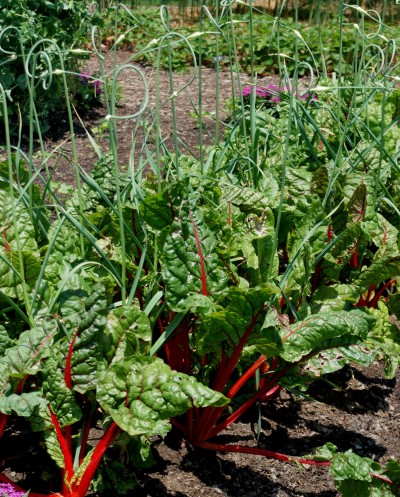
Planting a Smart Vegetable Garden
DOWNLOADDecember 21, 2023 - Mary Wilson, Rebecca Krans and Linda Whitlock, Michigan State University Extension
Thinking about planting your own vegetable garden may bring to mind images of bountiful fresh and healthy produce. Advance planning will be the key to your successful garden. Considering which vegetables you like, how much space you have for them and how you’ll meet each crop’s growing requirements before planting will help ensure you reap the full rewards at harvest.
When to plant?
Last frost date. Before planting your garden, determine the chances for a killing frost in your area by checking the frost-free chart at https://www.canr.msu.edu/home_gardening/uploads/files/4-25+Frost+free+date+table+REBECCA.pdf. This chart lists probable dates for the first and last frost of the year throughout Michigan, and helps you determine when you can first plant without minimal risk of a killing frost. Many people plant after the 50 percent probability date. If you plant before this date, there is a greater chance transplants will freeze or seeds rot and will need to be replaced.
Cool-season and warm-season vegetables. Cool-season vegetables such as lettuce, peas and spinach will thrive early in the season. Tomatoes, peppers and melons will perform best when air and soil temperatures are much warmer. Warm-season crops are more sensitive to late-season frosts, and may show signs of stunted growth if set out too early.
Soil temperature requirements. Some seeds, such as certain extra-sweet corn cultivars, will not germinate well unless the soil temperature at planting depth exceeds 60 degrees Fahrenheit. Beets, carrots and radishes will germinate at a minimum of 40 F. Planting seeds before reaching this soil temperature will result in little to no seed sprouting. See a condensed table of soil temperatures required for seed germination at https://sacmg.ucanr.edu/files/164220.pdf.

Smart choices – seeds or transplants?
Vegetables can be grown from seeds or small starter plants called transplants. Seeds provide a wider selection of vegetables than what you can usually find as transplants, but will take more planning and time to establish. You may have to start some seeds like tomatoes and peppers indoors so they reach maturity by the end of the growing season. Seed packets often contain a lot of the necessary information to help you be a successful smart gardener.
Seed types. Each seed type has something to offer depending on your needs, interests and values.
- Hybrid seedsare created by crossing two different parent varieties from the same species. They combine the best traits of these varieties to produce greater disease resistance, yield and uniformity. F-1 means the first generation offspring. These seeds are not genetically modified, but are created using traditional plant breeding techniques.
- Open-pollinated seeds have more genetic diversity and often more variation than hybrids. Pollination occurs by insects, birds, wind, humans or other natural mechanisms.
- Heirloom seeds are open-pollinated varieties that have been handed down for generations in a particular region or area, hand-selected by gardeners for a special trait.
Selecting transplants. Purchase transplants from a reputable source. Many retailers provide disease-resistant cultivars for various vegetables such as late blight-resistant tomatoes. Thoroughly inspect plants for signs of insects by checking under leaves and around stem tips. Avoid plants with leaves that are browning, spotted or wilting. A taller plant doesn’t mean a healthier or sturdier plant. If plants do not receive adequate light while developing, they often stretch toward the light and are weakened.
Smart planting techniques for transplants and seeds
Hardening off. Before placing transplants in your garden, “harden them off” to acclimate them from growing in a controlled greenhouse environment to your garden’s growing conditions. Start by placing transplants outside in a shaded and protected area for a few hours a day and keep them thoroughly watered. Over seven to 10 days, gradually increase the time the seedlings spend in the sun. They will soon become accustomed to outdoor conditions. When your transplants are ready to be planted, thoroughly water them in their containers and make sure the garden soil is well-watered.
Remove flowers. Transplants benefit from having their flowers removed at planting. This ensures the plant’s energy goes toward root development, which will be essential with transplanting. Sacrificing those initial flowers increases flowering (and fruiting) throughout the season.
Mulching. Apply a 1- to 3-inch layer of organic mulch around the plant’s base and not against the stem. Mulch will help maintain an even soil temperature, conserve water and help reduce competition from weeds. If transplants are tall, provide staking as necessary.
Succession planting. Planting seeds on multiple dates throughout the growing season (according to packet recommendations) can provide opportunities for continual harvesting of plants such as lettuce, radish, or herbs like cilantro and parsley. This can be done in rows or simply in smaller plots.
Maximize your space. Use every growing layer or tier within your garden. Root crops grow deep into the soil while tomatoes mature above ground. Lettuce is shallowly rooted and will grow as living mulch atop root crops such as beets and carrots. Plant carrots around developing tomato transplants or lettuce around developing root crops such as onions or radish. You can also increase your garden’s yield by growing vining crops such as tomatoes, melons, pole beans and cucumbers on trellises or any vertical structure. Harvesting is also easier, as there’s no stooping or hunching over!
Invite pollinators and other beneficial insects. Smart gardeners intersperse flowering herbs, annual flowers and native perennials among the vegetable garden. These plants add diversity to your garden, provide valuable food and shelter for native pollinators and beneficial insects that provide natural pest protection in your garden.

For more information on a wide variety of Smart Gardening topics, visit www.migarden.msu.edu or call MSU’s Lawn and Garden hotline at 1-888-678-3464.
This work is supported by the Crop Protection and Pest Management Program [grant no 2021-70006-35450] from the USDA National Institute of Food and Agriculture.



 Print
Print Email
Email





